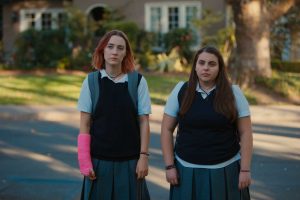By Erin Cabrey

The life of a high school senior is an awkward, bewildering and exhilarating one. You are on the precipice of so much change, looking into a collegiate future full of new beginnings, yet you are still very much stuck in the sameness of the life you have always known. As time goes by, the growing pains worsen as you are torn between what has been and what could be.
Moviegoers are lucky enough to experience this journey through the eyes of Christine “Lady Bird” McPherson (two-time Oscar nominee Saoirse Ronan) in Lady Bird, the directorial debut of actress and screenwriter Greta Gerwig.
The year is 2002 (according to Gerwig, to eliminate smartphones whilst presenting the post-9/11 world), and Lady Bird is setting out on her senior year of high school in Sacramento, CA, with the hope of breaking free of the “midwest of California” and heading to the East Coast.
“I wanna go where culture is, like New York,” she says to her equal parts stern and sensitive mom, played brilliantly by Laurie Metcalf. “Or at least Connecticut or New Hampshire, where writers live in the woods.” Her mom shoots down her dreams, and Lady Bird defiantly jumps out of a moving car. Thus begins her senior year.
Lady Bird goes to a Catholic school, an experience depicted with impeccable details. The school goes to Mass together, with girls and boys clearly separated within the pews. The girls wear long, unflattering grey kilts, and the cool girls decorate their ponytails with ribbons and roll their skirts a few times (much to the chagrin of the nuns). At school dances, located in a gym framed by collapsed bleachers, administrators instruct slow-dancing couples to “leave room for the Holy Spirit.”
Through Lady Bird’s senior year, where the passage of time is indicated through holidays and holy days (an Ash Wednesday mass scene was an excellent touch), there are pits and peaks. She has multiple male encounters that she plunges into far too earnestly, and both end in different forms of disaster. She struggles with her identity and tries to hop friend groups (a concept all too familiar for high schoolers), putting her relationship with her best friend Julie (Beanie Feldstein, a scene-stealing newcomer) in jeopardy.
The film captures the experience of being a young person, specifically in the 2000s, to a T, as is most evident in the pop culture references (music like Justin Timberlake and Alanis Morisette, and fashion like a striped long sleeved polo shirt I swear I owned 15 years ago). Most importantly, the film takes the adolescent disconnect between their youthful world and the often harsh reality that reveals itself with age and mirrors it in the bleak post-9/11 world and the characters’ engagement with the terror that is distant but still present in their lives.
The film is at its best, however, when it depicts Lady Bird’s home life. She does not live the picture-perfect life that some of her peers do. Her father Larry (Tracy Letts, in a beautifully nuanced performance), has lost his job, threatening the livelihood of the McPhersons, who already live a modest existence in a small home, while potentially dashing Lady Bird’s hope of a Sacramento exodus. It’s in this subplot that Gerwig masterfully paints the toll finances can take on a family: perhaps money does not buy happiness, but financial security can relieve stress that could give one a better shot at it. The family is not the typical “poor but morally rich” one; they’re good people, sure, but they are struggling in various ways.
Intertwined within this is Lady Bird’s relationship with her mom, the real standout of the film that expertly displays the intricate relationship between mothers and their young daughters, something that’s never quite been depicted onscreen so honestly. They are not best friends, but they are not enemies either. They deeply and constantly disagree about Lady Bird’s life and future, but neither woman is painted as right or wrong.
There is an unspoken, underlying love between them that is always present but not always visible. This is best demonstrated in a beautiful scene when Lady Bird gets into her mother’s car and breaks down into tears. Her mother does not ask what is wrong; she just knows she does not want to see her daughter in pain. She recommends that they do their “favorite activity,” and in a poignant scene, mother and daughter go to open houses together, wistfully imagining what their life would be like in a different home until Lady Bird’s pain washes away.
Lady Bird wonderfully captures the desperate cry for independence that so many young people experience as they prepare to move on from high school. It is a time when you learn who you can rely on and where your priorities lie. As Lady Bird so anxiously longs to move on from the world she knows too well, she learns she cannot leave every piece of her behind. What puts Lady Bird leagues above other teen coming-of-age dramas is that the story is equal parts unique and ubiquitous. It brilliantly balances the specific journey of a pink-haired Sacramento teen with the universal experience of feeling at once young and old, and through Lady Bird, allows the audience to feel the confusing vulnerability of reconciling who you are and who you want to be.




































































































































































































